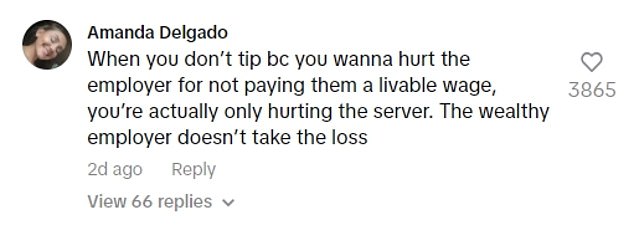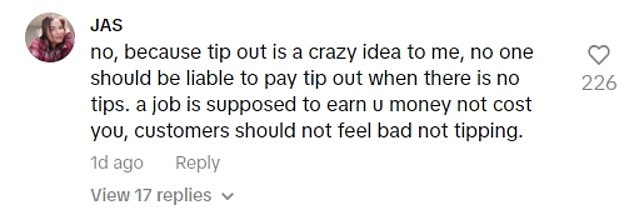Waitress’s frank tipping admission leaves internet divided
A waitress sparks a heated debate about tipping culture after making a video showing people how tips are handed out behind the scenes.
After an interaction with a customer, the woman raced online to create something her very first video for TikTok, where she revealed that each server’s tips are often split among a number of employees.
In the clip – which has been viewed nearly three million times – she said that while tipping is not mandatory, it could negatively impact the amount she takes home if she has to make up the difference when she does. shares with her colleagues.
When she informed the patron, the waiter was shocked and only then did she realize how few people know how tipping actually works.
The aspiring content creator recalled telling her, “Other people tip and some people tip more than others, and for me it evens out. I would just prefer my tables to tip.”
The waitress, who is from Canada, had an argument with a customer in her restaurant about leaving a tip
The lady fired back, “So you prefer? Why is that?’
The waitress, who explained in a subsequent video that she lives in Canada, then had to explain to this customer that if she didn’t get a tip, “the servers still have to put money on your bill, and you [are] That actually costs us money.’
“I feel like no one has ever explained this to her before,” the waitress said.
Apparently many of the people who came across her video had never had this explained to them before either.
Commentators expressed confusion and outrage at the system, which they called “tipping out.”
The concept of servers “tipping” to support other restaurant workers such as dishwashers, bartenders, and hosts has been around for a long time in both the United States and Canada.
Essentially, waitstaff must contribute a certain percentage of their total tips to a shared pool that goes to all tipping staff.
This exists so that employees who don’t have the opportunity to interact face-to-face with customers to win tips can still share in the prosperity.

The waitress explained how her tipping system works in a subsequent video
Each restaurant typically has a policy agreed upon between the owners and employees as to what a reasonable percentage is for the servers to “tip.”
This is also called tip bundling and can be done in two different ways.
Servers may be required to give away only a percentage of their tips.
Following an example of a business management consultancy firm Home baseIf a server makes $100 in tips on a given night, he might have to hand over 10 percent of that to the bartender, 7 percent to the busser, 5 percent to the runner and 3 percent to the host.
This would leave them with $75 in tips that they can keep free and clear.
Some restaurants, including Server’s, operate on a “percentage of sales” model.
Under this regime, servers must count everything they sold that night, including food and drinks.
So if a server sells $100 in drinks and $400 in food, plus earns $100 in tips, according to a hypothetical from Homebase, the restaurant can deduct certain percentages of food and drink sales from the tip total.

Under the “percentage of sales” model, if a waiter or waitress didn’t get enough tip, she would have to pay her customer’s bills out of her own pocket
The server may be required to give 10 percent of the $100 ($10) in drink sales to the bartender. They may also have to give 3 percent of the $400 ($13) in food sales to the runner.
Based on the $100 in tips they received, this hypothetical server would give $23 to the other staff and keep $77.
The TikToker broke down her single-night total in a subsequent video, which showed cash and card transactions, as well as the types of things customers bought, including food, wine, beer and whiskey.
However, she could not remember what specific percentages to give to different employees.
So if she didn’t get enough tips, she would theoretically have to pay her customers’ bills out of her own pocket.
Of course, this doesn’t mean she wouldn’t get paid or “pay” to be a waitress.
Over the course of a pay period, wait staff still have to earn some money the tipped minimum wage is in their state so that the restaurant’s tip pool policy is legally compliant.
Her viewers exploded in the comments with their thoughts on the issue, with some saying it shouldn’t be their responsibility to support waitstaff, while others blamed restaurants for this seemingly complicated system.





“If you don’t tip because you want to hurt the employer for not paying him a living wage, you’re really just hurting the server. The rich employer doesn’t take the loss,” one person wrote.
Another wrote that they thought that “tipping is a crazy idea to me, no one should be liable for paying out tips if there are no tips. a job should make you money and not cost you.”
‘Say what?! Giving a tip is inhumane. What’s wrong with the US?,” wrote a third.
Others were more outraged, feeling that no matter how restaurants function, it shouldn’t be up to them to tip a certain amount.
“Bro, that’s not OUR job. That is your employer’s job,” one person wrote.
Another said: ‘None of this is the customer’s problem.’
Americans are quite divided about the tilt debate, according to a Pew Research Poll 2023.
Overall, 21 percent of American adults believe that tipping is a choice, 29 percent say it is more of an obligation and 49 percent say it depends on the situation.
Younger Americans were more likely to view tipping as an obligation than older Americans.
Wealthier respondents were also more likely to see it as a duty than people with lower incomes.
